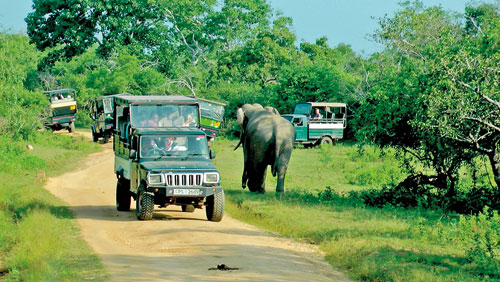National Parks: Killing the wild side of tourism
View(s):As large numbers of tourists visit the Yala wildlife park, political meddling has placed grave consequences on the animal habitat as activists and experts warn of how this could result in slowly killing the wild side of tourism.
A quick look at what happens inside Yala – a leopard or similar animal of significance is spotted by one jeep driver who then sends messages to all others informing them of a sighting. This then results in a large number of jeeps speeding up from all over to witness this sight causing commotion and traffic inside a park that is meant to protect the wild animals.
Today most of these animals have become habituated with the sound of jeeps especially those found in Block 1 of the Yala National Park. However, this has caused accidents resulting in the deaths of a number of known and lesser known species.
Moreover, with the upcoming winter season the industry is expecting large numbers of travellers who have already booked trips to the Yala National Park as a result of which the government has taken measures to allow for an increase in the number of jeeps to be sent inside the park, Wildlife Department sources said.
This decision had been taken following a meeting between Prime Minister Ranil Wickremesinghe and the department officials and as a result the park would from November 28 – December 31 increase the number of jeeps entering the park to 500 per day and thereafter reduce it to 300 per day again.
It must be noted that the number of jeeps entering the park on a given day is not what matters but the consequences arising out of it as most drivers were unruly with no respect to the wildlife.
With about 800 jeeps roaming the wild a better re-distribution of these are required in the other blocks number 3, 4 and 5, Wildlife Department’s former Director General Dr. Sumith Pilapitiya told the Business Times on Wednesday. Animals in the blocks other than block one would then gradually get habituated to the jeeps but this would take some time, it was noted.
He explained that with a national park for animal conservation it should also help meet the livelihoods of the surrounding villagers. In this respect, the social and humanitarian crisis arising from the reduction of the jeeps would impact them strongly.
As a result, the industry has together with the Wildlife Department drawn up a plan for the management of the park that also gained approval from the Prime Minister’s office.
Despite the approval to implement the plan, two influential ministers were said to have again asked for an increase in the number of jeeps entering Yala.

File picture of jeeps typically crowding round a hapless elephant
Dr. Pilapitiya noted that the minister of wildlife should not give political cover to pressure from other politicians and the minister in charge should give cover to the department, because the minister should look after the officials of his department.
“The politician should not interfere with the implementation of the plan but on the contrary hold the department accountable for the implementation of the plan,” he asserted.
Early in the year when the Wildlife Department had recommended that the national park be closed for three months, subject Minister Jayawickrama Perera had requested that it be closed for two months based on a request of Housing Minister Sajith Premadasa representing the area.
Then once the park was opened early the limited number of vehicles entering it was gradually increased and then brought down from around 500 to 300 following the intervention of Prime Minister Ranil Wickremesinghe.
Dr. Pilapitiya noted that according to the plan drawn out they were hoping to ensure discipline among drivers by providing them training and an accreditation and registration of the jeeps to ensure they would have a better understanding of their job. Once this is carried out then even tourists could pick the ones they prefer to ride with when they visit the park based on their performance.
According to the plan the drivers would be suspended and financial penalties imposed if any were caught violating the rules.
Some of the key aspects of the plan currently under implementation like ensuring a strict speed limit of 25 kmph and placing speed bumps are expected to ease the rash driving that have reportedly resulted in tourists also being injured.
However, other new plans would be to ensure that travellers are not inconvenienced by travelling to the park only to be told that they would not be able to tour inside but have to come back tomorrow. In this respect, the authorities have planned to establish an e-ticket so that tourists could find out ahead when they can visit the park.
Commenting on the inadequate staff he pointed out that even during his tenure as the DG at the department there were over 500 approved cadre positions vacant due to insufficient funds to pay salaries.
He also said that the department has been assigned to carry out a scientific study on the carrying capacity at Yala that would determine the number of visitors and vehicles that could enter the park at a given period. The assessment scheduled to be completed within six months is expected to come into effect by January 2020.
The former DG also explained that having been a visitor to the park for a number of years since his childhood he had observed that there was a visible reduction in the number of animals.
He also pointed to a number of entries in social media sites like TripAdvisor made by foreign visitors to the Yala park that indicated the negative aspect of the quality of tourism and believed it would be a matter of time before tourists were likely to stop visiting the location.
The plan drawn up itself has indicated a constant rise in the number of tourists visiting the park and had noted that most had come to simply view the animals and not observe them.
Other problems at the park were the issue of a lack of guides since that number was small compared to the number of vehicles entering the park, Dr. Pilapitiya noted.
“Upto 2005 every vehicle went with a guide – but now the number of guides is small compared to vehicles so the jeeps are allowed to go without guides,” he said.
Rights activists complain that the park is increasingly used to serve the purpose of tourism and an attraction for the travellers as opposed to being a site for the protection of the wild animals to roam freely without hindrance or accidents. The real reason for the park was the conservation of the wild side of Sri Lanka.


